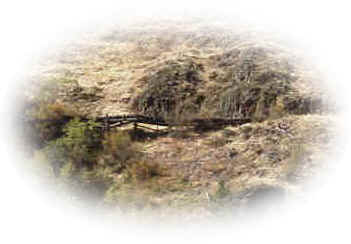|
Waterwheel Powered Electricity
|
|
|
|
|
|
Wooden Waterwheel Powered First Generator |
| Daniel Frank Brown built a system of gears using hardwood cogs in 1888 and geared an electric generator to the wooden waterwheel at his father's planning, shingle and chopping mill on the Walla Walla River about half a mile south of Cole's Crossing. |
Brown used
the power from the generator to light the mill and sold the surplus t o a
few nearby homes. From this humble beginning grew the present City
Light and Power that serves the homes and businesses in the
Milton-Freewater area. o a
few nearby homes. From this humble beginning grew the present City
Light and Power that serves the homes and businesses in the
Milton-Freewater area.After beginning his electrical system, Brown continued to operate it on his own for about two years. He had quite a problem selling electrical service, as most people wouldn't trust this new service as being safe enough to have in their homes. The city of Milton, in a special bond election August 20, 1891, received voter approval to issue $5,000 in bonds to buy the electrical system from Brown. The system at that time selected clients and charged, not according to the amount of electricity used but by the number of lights in the customer's home. It took a favorable vote of the city council before a family could receive electrical service. In 1929, the city proved upon 6,400 horsepower of power rights from water of the Walla Walla River. A wood flume 48 inches in diameter and five miles long was construct to bring water under pressure into the city's power house. Diesel engines powered generators in two other city power sites. |
 In 1946, the
city contracted for power at Bonneville dam. Shortly after Milton
and Freewater merged in 1951 the new city purchased from Pacific Power
and Light the electrical distribution system that served Freewater and
the surrounding area.
In 1946, the
city contracted for power at Bonneville dam. Shortly after Milton
and Freewater merged in 1951 the new city purchased from Pacific Power
and Light the electrical distribution system that served Freewater and
the surrounding area.In 1959, the city contracted for power produced at Priest Rapids and Wanapum Dam and in 1963 for power produced by the atomic reactor at Hanford.In 1959, the city contracted for power produced at Priest Rapids and Wanapum Dam and in 1963 for power produced by the atomic reactor at Hanford. With its power requirements fulfilled through the several contracts, the city shut down its own production plant in 1963. |
| During the time that the first power system was being developed here, the calvary was busy protecting settlers from Indians. Chief Joseph, even though his Nez Perce Indians had been badly beaten in battle with the cavalry two years before, was still claiming the entire territory as land belonging to the Indians. |
|
|